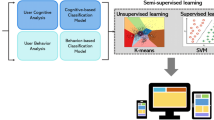Abstract
With the burgeoning complexity and capabilities of modern information appliances and services, user modelling is becoming an increasingly important research area. Simple user profiles already personalise many software products and consumer goods such as digital TV recorders and mobile phones. A user model should be easy to initialise, and it must adapt in the light of interaction with the user. In many cases, a large amount of training data is needed to generate a user model, and adaptation is equivalent to retraining the system. This paper briefly outlines the user modelling problem and work done at BTexact on an Intelligent Personal Assistant (IPA) which incorporates a user profile. We go on to describe FILUM, a more flexible method of user modelling, and show its application to the Telephone Assistant component of the IPA, with tests to illustrate its usefulness.
Access this chapter
Tax calculation will be finalised at checkout
Purchases are for personal use only
Preview
Unable to display preview. Download preview PDF.
Similar content being viewed by others
References
Azvine, B., D. Djian, K.C. Tsui and W. Wobcke, The Intelligent Assistant: An Overview. Lecture Notes in Computer Science, 2000(1804): p. 215–238.
Azvine, B. and W. Wobcke, Human-centred intelligent systems and soft computing. Bt Technology Journal, 1998. 16(3): p. 125–133.
Baldwin, J.F., The Management of Fuzzy and Probabilistic Uncertainties for Knowledge Based Systems, in Encyclopedia of AI, S.A. Shapiro, Editor. 1992, John Wiley. p. 528–537.
Baldwin, J.F., J. Lawry and T.P. Martin, A mass assignment based ID3 algorithm for decision tree induction. International Journal of Intelligent Systems, 1997. 12(7): p. 523–552.
Baldwin, J.F., J. Lawry and T.P. Martin. Mass Assignment Fuzzy ID3 with Applications. in Proc. Fuzzy Logic-Applications and Future Directions. 1997. pp 278–294 London: Unicom.
Baldwin, J.F. and T.P. Martin, Fuzzy classes in object-oriented logic programming, in Fuzz-Ieee’ 96-Proceedings of the Fifth Ieee International Conference On Fuzzy Systems, Vols 1–3. 1996. p. 1358–1364.
Baldwin, J.F. and T.P. Martin. A General Data Browser in Fril for Data Mining. in Proc. EUFIT-96. 1996. pp 1630–1634 Aachen, Germany.
Baldwin, J.F., T.P. Martin and B.W. Pilsworth, FRIL-Fuzzy and Evidential Reasoning in AI. 1995, U.K.: Research Studies Press (John Wiley). 391.
Bezdek, J.C., Fuzzy Models. IEEE Trans. Fuzzy Systems, 1993. 1(1): p. 1–5.
Bezdek, J.C., What is Computational Intelligence?, in Computational Intelligence-Imitating Life, J.M. Zurada, R.J. Marks II, and C.J. Robinson, Editors. 1994, IEEE Press. p. 1–12.
Billsus, D. and M.J. Pazzani. A Hybrid User Model for News Story Classification. in Proc. User Modeling 99. 1999. pp 99–108 Banff, Canada.
Bushey, R., J.M. Mauney and T. Deelman. The Development of Behavior-Based User Models for a Computer System. in Proc. User Modeling 99. 1999. pp 109–118 Banff, Canada.
Case, S.J., N. Azarmi, M. Thint and T. Ohtani, Enhancing e-Communities with Agent-Based Systems. IEEE Computer, 2001. 33(7): p. 64.
Hermens, L.A. and J.C. Schlimmer, A Machine-Learning Apprentice for The Completion of Repetitive Forms. IEEE Expert-Intelligent Systems & Their Applications, 1994. 9(1): 28–33.
Horvitz, E., Uncertainty, action, and interaction: in pursuit of mixed-initiative computing. Ieee Intelligent Systems & Their Applications, 1999. 14(5): p. 17–20.
Horvitz, E., J. Breese, et al. The Lumière Project: Bayesian User Modeling for Inferring the Goals and Needs of Software USers. in Proc. Fourteenth Conference on Uncertainty in Artificial Intelligence. 1998. pp 256–265 (see also http://www.research. microsoft.com/research/dtg/horvitz/lum.htm ) Madison, WI.
Langley, P. User Modeling in Adaptive Interfaces. in Proc. User Modeling 99. 1999. See http://www.cs.usask.ca/UM99/Proc/invited/Langley.pdf Banff, Canada.
Lau, T. and E. Horvitz. Patterns of Search: Analyzing and Modeling Web Query Refinement. in Proc. User Modeling 99. 1999. pp 119–128 Banff, Canada.
Linton, F., A. Charron and D. Joy, Owl: A Recommender System for Organization-Wide Learning. 1998, MITRE Corporation. http://www.mitre.org/ technology/tech_tats/modeling/owl/Coaching_Software_Skills.pdf.
Martin, T.P. Incremental Learning of User Models-an Experimental Testbed. in Proc. IPMU 2000. 2000. pp 1419–1426 Madrid.
Martin, T.P. and B. Azvine. Learning User Models for an Intelligent Telephone Assistant. in Proc. IFSA-NAFIPS 2001. 2001. pp 669–674 Vancouver: IEEE Press.
Muggleton, S., Inductive Logic Programming. 1992: Academic Press. 565.
Nunes, P. and A. Kambil, Personalization? No Thanks. Harvard Business Review, 2001. 79(4): p. 32–34.
Pazzani, M. and D. Billsus, Learning and revising user profiles: The identification of interesting Web sites. Machine Learning, 1997. 27(3): p. 313–331.
Pohl, W., Logic-based representation and reasoning for user modeling shell systems. User Modeling and User-Adapted Interaction, 1999. 9(3): p. 217–282.
Quinlan, J.R., Induction of Decision Trees. Machine Learning, 1986. 1: p. 81–106.
Quinlan, J.R., C4.5: Programs for Machine Learning. 1993: Morgan Kaufmann.
Rossiter, J.M., T. Cao, T.P. Martin and J.F. Baldwin. A Fril++ Compiler for Soft Computing Object-Oriented Logic Programming. in Proc. IIZUKA2000, 6th International Conference on Soft Computing. 2000. pp 340–345 Japan.
Rossiter, J.M., T.H. Cao, T.P. Martin and J.F. Baldwin. User Recognition in Uncertain Object Oriented User Modelling. in Proc. Tenth IEEE International Conference On Fuzzy Systems (Fuzz-IEEE 2001). 2001. pp Melbourne.
Salton, G. and G. Buckley, Term-weighting Approaches in Automatic Text Retrieval. Information Processing and Management, 1988. 24: p. 513–523.
Webb, G., Preface to Special Issue on Machine Learning for User Modeling. User Modeling and User-Adapted Interaction, 1998. 8(1): p. 1–3.
Yiming, Z. Fuzzy User Profiling for Broadcasters and Service Providers. in Proc. Computational Intelligence for User Modelling. 1999. http://www.fen.bris.ac.uk/engmaths/research/aigroup/martin/ci4umProc/Zhou.pdf Bristol, UK.
Author information
Authors and Affiliations
Editor information
Editors and Affiliations
Rights and permissions
Copyright information
© 2002 Springer-Verlag Berlin Heidelberg
About this paper
Cite this paper
Martin, T.P., Azvine, B. (2002). Adaptive User Modelling in an Intelligent Telephone Assistant. In: Bustard, D., Liu, W., Sterritt, R. (eds) Soft-Ware 2002: Computing in an Imperfect World. Soft-Ware 2002. Lecture Notes in Computer Science, vol 2311. Springer, Berlin, Heidelberg. https://doi.org/10.1007/3-540-46019-5_8
Download citation
DOI: https://doi.org/10.1007/3-540-46019-5_8
Published:
Publisher Name: Springer, Berlin, Heidelberg
Print ISBN: 978-3-540-43481-8
Online ISBN: 978-3-540-46019-0
eBook Packages: Springer Book Archive




